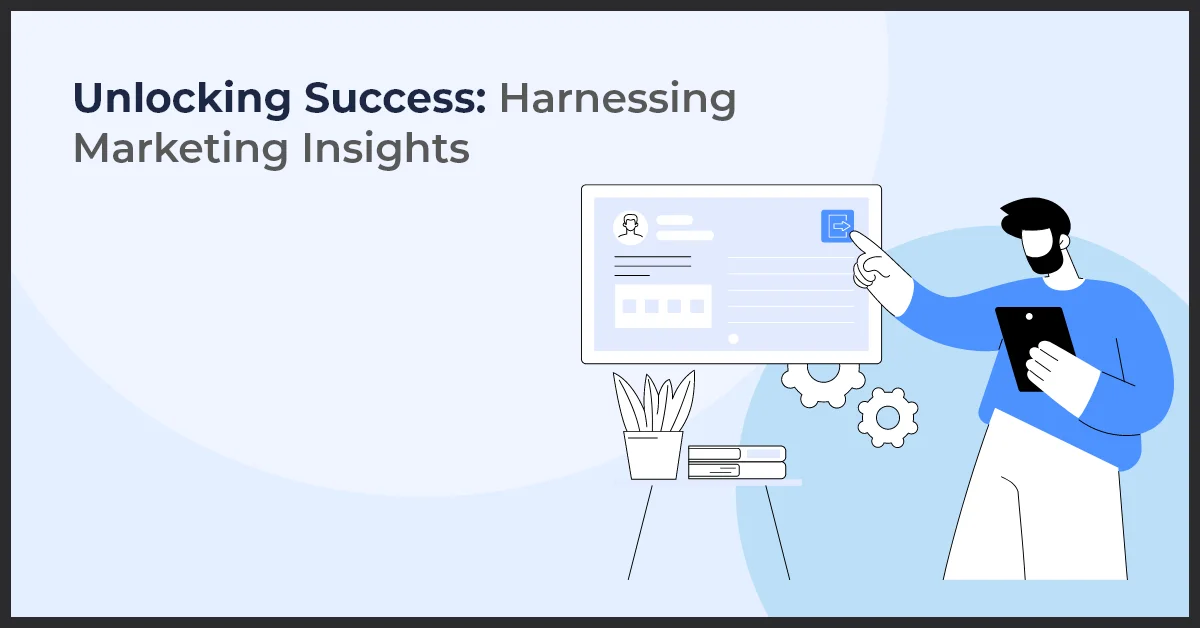Unlocking Success: Harnessing Marketing Insights

Published on: November 1, 2023
Updated on: June 25, 2024
641 Views
- Analytics
10 min read
Marketing Insights play a crucial role in the decision-making processes of businesses. By understanding the definition and scope of marketing insights, you can unlock the potential to drive growth and profitability.
1.1 Definition and Scope of Marketing Insights
Marketing insights refer to the valuable knowledge derived from a comprehensive analysis of customer behavior, data analytics, market research, and competitive analysis. These insights act as a compass, guiding businesses in making informed decisions.
Marketing insights are instrumental in understanding the ever-evolving needs and preferences of consumers. By translating data into actionable strategies, businesses can forge stronger connections with their audience and gain a competitive advantage.
1.2 Benefits of Marketing Insights
The power of marketing insights lies in their ability to provide businesses with a deeper understanding of their customers. By delving into their desires, pain points, and motivations, businesses can tailor their marketing efforts to resonate with their target audience. This personalization ultimately leads to increased customer satisfaction, loyalty, and ultimately, revenue.
Furthermore, marketing insights empower businesses to identify untapped opportunities, anticipate market trends, and make informed strategic decisions. Armed with meaningful data, businesses can optimize their operations, develop effective marketing campaigns, and stay one step ahead of their competition.
1.3 Key Components of Marketing Insights
To unlock the full potential of marketing insights, businesses must utilize various key components. These include customer behavior analysis, which allows businesses to uncover patterns and preferences to inform their marketing strategies.
Data analytics and interpretation provide businesses with powerful tools to decipher complex data sets, enabling them to extract valuable insights and trends. Market research methods and techniques offer systematic approaches to gathering and analyzing data specific to target markets, providing a solid foundation for decision-making.
Lastly, competitive analysis is essential in understanding the landscape in which a business operates. It helps identify market gaps, benchmarks against rivals' strategies, and uncovers unique value propositions to differentiate a brand.
By incorporating these components, businesses can harness the full potential of marketing insights and pave the way to success.
Gathering Data and Analysis
2.1 Data Collection Techniques
When it comes to gathering data for marketing insights, businesses have various techniques at their disposal. These techniques include:
- Primary and secondary data sources: Primary data is collected directly from customers and can include surveys, interviews, focus groups, and observations. Secondary data, on the other hand, is collected from existing sources such as market research reports, government publications, and industry studies.
- Surveys, interviews, focus groups, and observations: These methods allow businesses to directly engage with customers to gather valuable information and insights. Surveys are often conducted through questionnaires, interviews involve one-on-one discussions, focus groups bring together a small group for a focused discussion, while observations involve watching and recording customer behavior.
- Leveraging customer feedback and reviews: Customer feedback and reviews, whether gathered through online platforms, social media, or customer support channels, can provide valuable insights into customer preferences, needs, and experiences.
2.2 Importance of Data Quality and Integrity
When it comes to data analysis, the quality and integrity of the data play a crucial role in generating accurate and reliable insights. Businesses should consider the following:
- Ensuring accurate and reliable data: Data accuracy and reliability can be ensured through robust data collection methods, proper documentation, and minimizing errors during data entry and processing.
- Data cleaning, validation, and verification: Before proceeding with the analysis, it's essential to clean, validate, and verify the collected data to remove any inconsistencies, errors, or missing values that may impact the analysis.
- Maintaining data privacy and security: Businesses must prioritize data privacy and security by implementing measures to protect customer data from unauthorized access, breaches, or misuse.
2.3 Data Analysis and Interpretation
Once the data is collected and cleaned, it's time to analyze and interpret it to extract meaningful insights. Businesses can utilize statistical analysis tools and software to:
- Conduct statistical analysis: Statistical analysis helps identify patterns, correlations, and trends within the data, enabling businesses to understand the relationships between different variables.
- Interpret data to extract meaningful insights: By carefully examining the analyzed data, businesses can uncover valuable insights about customer behaviors, preferences, buying patterns, and market trends.
- Visualize data for better understanding and communication: Data visualization tools can help businesses present their findings in a more visually appealing and easy-to-understand format, facilitating effective communication and decision-making.
Customer Understanding and Segmentation
3.1 Importance of Customer Understanding
Customer understanding plays a crucial role in the success of any marketing campaign. By identifying customer needs and preferences, businesses can tailor their offerings to better meet the demands of their target audience. This not only enhances customer satisfaction but also drives customer loyalty and repeat business.
Additionally, customer understanding enables businesses to craft customer-centric marketing strategies. By gaining insights into what motivates their customers, businesses can create more relevant and personalized messaging that resonates with their target audience. This leads to higher engagement levels and increased conversion rates.
3.2 Target Audience Segmentation
Target audience segmentation involves dividing the overall market into distinct groups based on various criteria. This segmentation is typically done using demographic, psychographic, and behavioral factors.
By segmenting their target audience, businesses can effectively target their marketing efforts toward specific customer groups. This allows for more personalized marketing messages, optimized advertising spending, and improved return on investment.
Understanding buyer personas and customer journeys is an essential component of target audience segmentation. Buyer personas represent fictional profiles that encompass the characteristics and behaviors of different customer groups. Mapping out the customer journey helps businesses understand the touchpoints and interactions customers have with their brand throughout the buying process.
Strategies for Effective Marketing Insights
4.1 Branding and Positioning
- Creating a strong brand identity: Building a brand that resonates with your target audience is essential for effective marketing. Through consistent messaging, visuals, and experiences, you can establish a strong brand identity that leaves a lasting impression.
- Differentiation strategies for competitive advantage: Standing out from your competitors is crucial in today's crowded marketplace. Develop strategies to differentiate your brand by highlighting unique selling points, offering exceptional customer service, or focusing on niche markets.
4.2 Advertising and Promotional Strategies
- Selecting the right channels and mediums: Understanding your target audience's media consumption habits will help you select the most effective advertising channels. Whether it's through traditional mediums like TV, radio, or print, or digital platforms such as social media or search engine ads, choose the channels that reach your audience most efficiently.
- Crafting compelling marketing messages: Effective marketing messages capture attention, create desire, and drive action. Use persuasive language, storytelling techniques, and emotional appeals to connect with your audience and convince them of the value your product or service offers.
4.3 Digital Marketing Trends and Tactics
- Maximizing online presence and visibility: In today's digital age, having a strong online presence is vital. Optimize your website for search engines, maintain active social media profiles, and engage with your audience through relevant content and interactions.
- Leveraging search engine optimization (SEO) and pay-per-click (PPC) advertising: Increase your website's visibility on search engine results pages through SEO techniques and attract targeted traffic with PPC advertising campaigns.
- Harnessing the power of content marketing and influencer collaborations: Create valuable and shareable content to engage with your audience, establish thought leadership, and drive brand awareness. Collaborate with influencers or industry experts to extend your reach and credibility.
Measuring Success and Improving Performance
5.1 Customer Relationship Management (CRM)
Customer Relationship Management (CRM) systems are an essential tool for managing customer interactions. By utilizing CRM systems, businesses can gather and analyze data on customer behaviors, preferences, and interactions across different channels.
With a CRM system, businesses can enhance customer satisfaction and build loyalty by providing personalized experiences and targeted marketing campaigns. By understanding customer needs and preferences, businesses can deliver tailored offers and recommendations.
5.2 Sales Forecasting and Performance Measurement
Developing accurate sales forecasts is crucial for effective marketing insights. By analyzing historical sales data and market trends, businesses can estimate future sales and optimize their marketing strategies accordingly.
Key metrics such as sales revenue, conversion rates, and customer acquisition cost can provide valuable insights into sales performance. By monitoring and analyzing these metrics, businesses can identify areas for improvement and adjust their marketing efforts to maximize sales success.
5.3 Customer Satisfaction and Loyalty Analysis
Assessing customer satisfaction levels is vital for understanding and improving performance. Surveys and feedback from customers can provide valuable insights into their satisfaction levels and identify areas where improvements can be made.
Implementing strategies to enhance customer loyalty and retention is crucial for long-term success. By analyzing customer feedback and preferences, businesses can develop targeted loyalty programs and personalized experiences to nurture customer loyalty and strengthen relationships.
Pricing Strategies and Product Development
6.1 Pricing Strategies and Elasticity Analysis
Determining optimal pricing based on customer perceptions can significantly impact the success of your marketing efforts. By understanding how your customers perceive the value of your products or services, you can strategically set prices that maximize profitability while still meeting customer expectations.
To achieve this, it is crucial to analyze price elasticity and its impact on demand. Price elasticity refers to the sensitivity of customer demand to changes in price. By conducting elasticity analysis, you can identify the price points at which demand increases or decreases significantly.
6.2 Product Development and Innovation
Utilizing customer insights is essential in driving product development and innovation. By understanding your customers' needs, preferences, and pain points, you can create products or services that better meet their expectations and address their specific challenges.
Innovation plays a vital role in staying ahead of the competition and adapting to evolving customer needs. By continuously innovating your products or services, you can ensure that you remain relevant in the market and provide solutions that are in line with the changing preferences of your target audience.
Conclusion
Marketing insights play a crucial role in shaping and guiding effective marketing strategies. Throughout this content, we have explored various aspects of marketing insights, from understanding and gathering data to customer segmentation and measuring success.
It is important to recap the significance of marketing insights. By analyzing data and understanding customers, businesses can make informed decisions and tailor their marketing efforts to align with their target audience's needs and preferences.
Utilizing marketing insights is crucial for driving business success. These insights provide valuable information that helps businesses identify opportunities, improve customer experiences, and effectively allocate resources. By leveraging marketing insights, businesses can gain a competitive edge and achieve their goals more efficiently.
However, it's essential to recognize that marketing insights are an ongoing and iterative process. The marketplace is constantly evolving, and consumer behaviors are dynamic. Therefore, businesses must continuously gather and analyze data to stay ahead of the curve, adapt their strategies, and better serve their customers. Continuous improvement is key to staying relevant and meeting consumer demands.
In conclusion, marketing insights are an invaluable asset for any business seeking growth and success. By understanding their importance, utilizing them effectively, and embracing continuous improvement, businesses can propel themselves toward achieving their marketing objectives and driving long-term business success.



